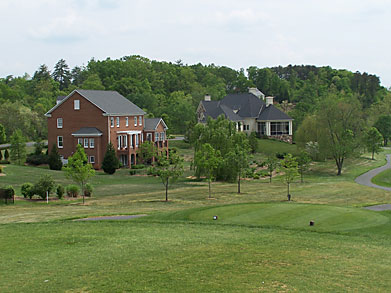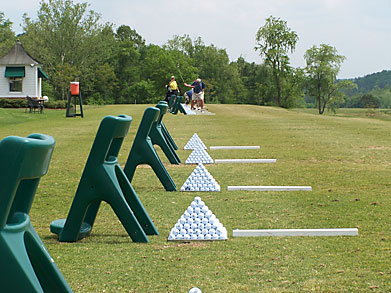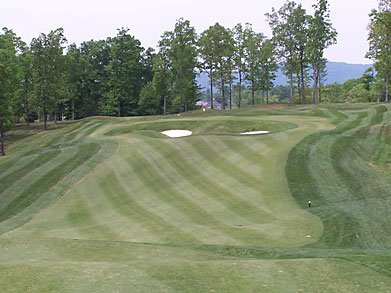Pyramid scheme: Glenmore's driving range is amply sized and professionally outfitted.
Golf Course Review
Glenmore is one of those communities that suddenly appears along a stretch of country road and, yet, is close to everything. Just a 20-minute drive to the University of Virginia, the gated Glenmore is also conveniently close to all other conveniences and necessities, like hospitals and shopping within 15 minutes. Its east-of-Charlottesville location offers alternative air transportation options for those willing to drive about an hour to Richmond International Airport. The Washington, D.C., area airports are two hours away.
Glenmore appeals to those who still work and those who don’t with roughly equal numbers of retirees, young families and empty nesters who are still working at least part time. “The home office,” says lead broker Tom Pace, “is an important room to have [in Glenmore].”
Housing runs the gamut in the community. We found what Glenmore calls their “Scottish Homes” to be especially interesting. Eleven choices of models are available. At 2,100 to 3,700 square feet on lots from 2/10 and acre to ½ acre, these low maintenance homes fetch prices from around $550,000 to $800,000. For $1,000 annually, an outside contractor handles all landscaping on the property, including mowing, mulch, fertilizer and aeration. As for homes in the rest of the 1,300-acre community, they tend toward indigenous brick exteriors, with a good representation of hardy plank and stone. Pace says Glenmore’s “bread and butter” house is about 3,000 square feet and sells for around $750,000. There are no multi-family homes in Glenmore, although cottages are available (close together and some as small as 1,700 square feet) in the $400K range. Owners of the cottages are required to purchase landscaping services for about $800 annually. Houses in the rest of Glenmore range in price from $550,000 to more than $2 million.
Glenmore has not been stingy with its non-residential land; 500 acres, including walking trails, a two-acre park, athletics fields and the golf course, will not be developed. Just a small handful of Glenmore’s 800 lots remain available, and almost 700 of them have houses already. This is a popular community near a popular town for both workers and retirees, and Glenmore’s resale values over the last few years have been strong.

Tree lines provided nice framing for both fairways and some of the greens, and houses rarely encroached. Greens were aerated and heavily top-dressed when we played the course, but the rest of the layout was in nice condition; we didn’t have a bad lie in fairways. Our only wish is that Glenmore would relocate the large, dark scoreboard that dominates the back of the 18th green. Better to let the dramatic clubhouse form an uninterrupted backdrop on this good finishing hole.
Full family golf membership initiation fee is $20,000 with monthly dues of $411, both reasonable not only for golf of this quality but also for the 15 tennis courts (nine lighted), fitness center, and large swimming pool, as well as both casual and more serious dining in the clubhouse, with views out to and across the Rivanna River to Thomas Jefferson’s Monticello.
From the Scottish style homes to the golf course design unashamedly influenced by Ross, McKenzie and the other greats, Glenmore is true to its name. Coming up the long, uphill finishing hole to the dramatic clubhouse, only the elimination of the scoreboard and addition of a bagpiper might have improved the scene. For info, contact Lead Broker Tom Pace at 800-776-5111, or
Eyes have it: You wonder if architect John LaFoy was having a little fun when he put a "human face" on one of the holes at Glenmore.

























